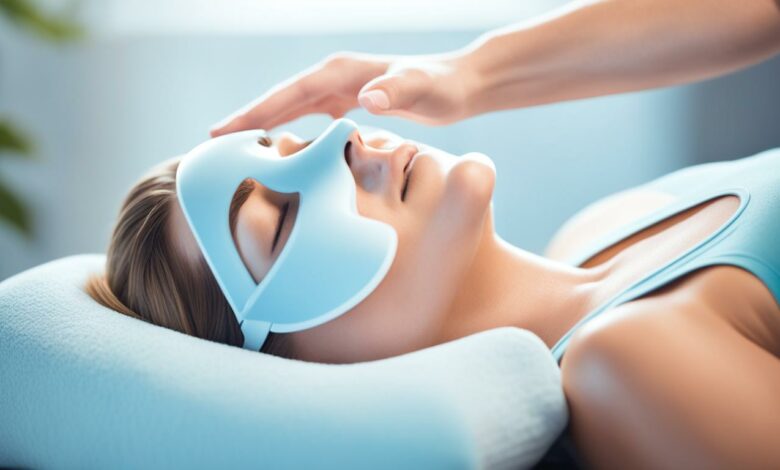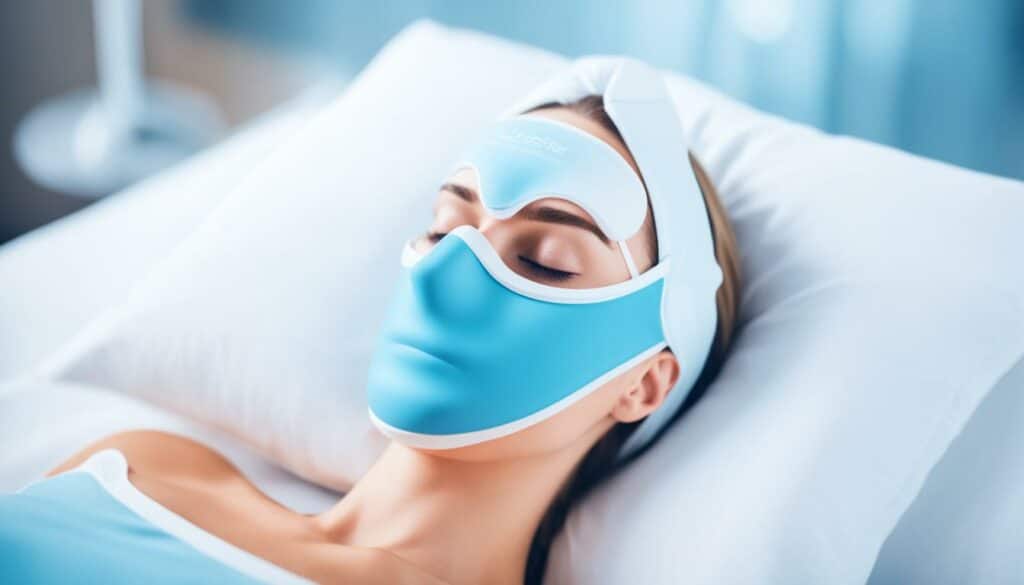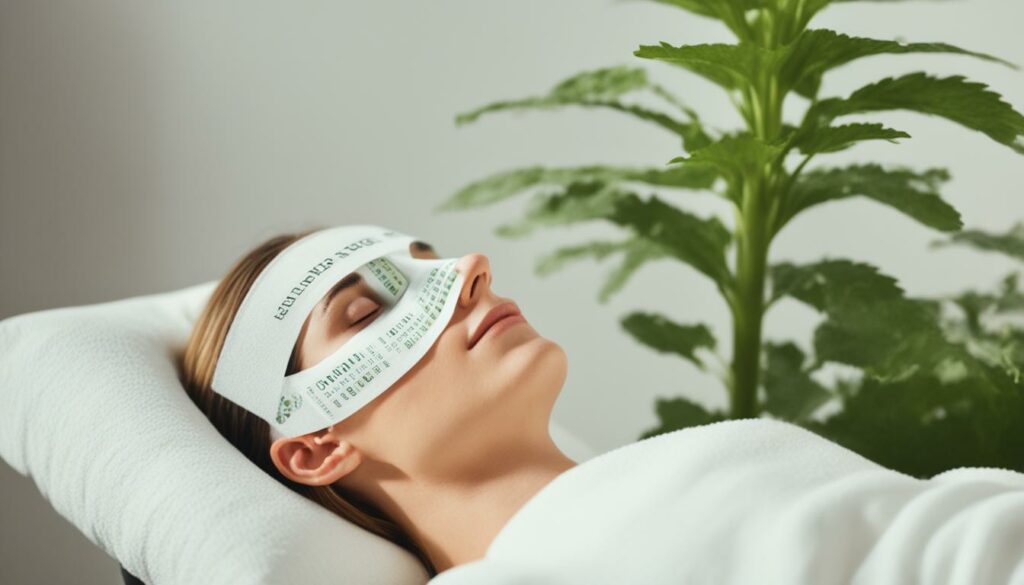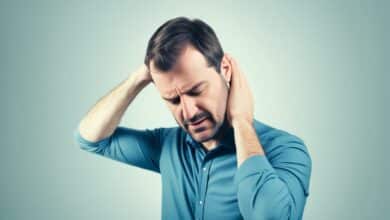Eye Socket Pain in One Eye: Causes & Relief

Experiencing eye socket pain in one eye can be discomforting and concerning. This specific type of pain can have various causes, ranging from sinusitis and migraines to eye infections and underlying medical conditions. Finding the right treatment and relief options is crucial for restoring comfort and ensuring optimal eye health.
Key Takeaways:
- Eye socket pain in one eye can be caused by sinusitis, migraines, eye infections, trauma, or underlying medical conditions.
- Consulting a healthcare professional is essential for proper diagnosis and personalized treatment plans.
- Traditional treatment options include over-the-counter pain relievers, warm compresses, and eye drops.
- Natural remedies such as cold compresses, herbal eye drops, and stress reduction techniques may provide temporary relief.
- Preventive measures like maintaining proper eye hygiene, limiting screen time, and wearing protective eyewear can help prevent eye socket pain.
Understanding Eye Socket Pain
Before diving into the causes and relief options, it’s essential to understand what eye socket pain is and how it differs from general eye discomfort. Eye socket pain refers to a specific type of pain that occurs within the eye socket, the bony structure that surrounds and protects the eye. This pain can manifest as a throbbing or sharp sensation, often localized to one eye. It can be quite distressing and interfere with daily activities.
Unlike general eye discomfort, which can be caused by factors such as dryness or strain, eye socket pain tends to be more severe and persistent. It is often associated with underlying conditions or injuries. One-sided eye pain, also known as one-sided eye pain, can occur when the pain is primarily experienced in a single eye.
Individuals experiencing eye socket pain should pay attention to accompanying symptoms such as headaches, blurred vision, sensitivity to light, and swelling around the eye. These symptoms may provide clues to the underlying cause of the pain and help guide appropriate treatment options.
“Eye socket pain refers to a specific type of pain that occurs within the eye socket, the bony structure that surrounds and protects the eye.”
Common Causes of Eye Socket Pain in One Eye
Eye socket pain that occurs in one eye can have various underlying causes. Understanding these causes is crucial for determining the most appropriate treatment approach. In this section, we will explore the common factors that can contribute to eye socket pain in one eye.
Sinusitis
Sinusitis, an inflammation of the sinuses, can cause pain and pressure around the eyes. When the sinuses become congested or infected, the inflammation can extend to the eye socket, resulting in discomfort and pain in one eye.
Migraines
Migraines are severe, recurrent headaches that can be accompanied by eye symptoms. Some individuals may experience eye socket pain during a migraine attack, usually on one side. The pain may be pulsating and worsen with physical activity.
Eye Infections
Infections in the eye, such as conjunctivitis or keratitis, can lead to eye socket pain in one eye. These infections can cause inflammation and discomfort, affecting the surrounding structures including the eye socket.
Trauma or Injury
Physical trauma or injury to the eye or surrounding area can result in localized pain in the affected eye socket. This can occur due to accidents, falls, or direct impact to the eye area.
Underlying Medical Conditions
Certain medical conditions can contribute to eye socket pain. Conditions such as optic neuritis, glaucoma, autoimmune disorders, or cranial nerve inflammation may manifest as pain in one eye socket.
It is important to note that these are just some of the common causes of eye socket pain in one eye. The specific cause may vary depending on individual circumstances. Consulting with a healthcare professional is essential for accurate diagnosis and appropriate treatment.
Seeking Relief: Treatment Options for Eye Socket Pain
Finding relief from eye socket pain in one eye is essential for regaining comfort and improving overall well-being. In this section, we will explore various treatment options to alleviate eye socket pain and promote healing.
1. Over-the-Counter Pain Relievers
Over-the-counter pain relievers, such as ibuprofen or acetaminophen, can help reduce the discomfort caused by eye socket pain. These medications can provide temporary relief and minimize inflammation within the affected area.
2. Warm Compresses
Applying warm compresses to the affected eye can help alleviate eye socket pain symptoms. The heat from the compress increases blood circulation, promotes relaxation, and soothes the surrounding muscles and tissues. Simply soak a clean cloth in warm water, wring out the excess, and gently place it over the closed eye for a few minutes.
3. Eye Drops
In some cases, eye drops may be recommended by a healthcare professional to relieve eye socket pain. These drops can help lubricate the eyes, reduce irritation, and minimize the sensation of discomfort. It’s important to consult with a healthcare professional before using any eye drops to ensure they are suitable for your specific condition.
4. Lifestyle Adjustments
Implementing certain lifestyle adjustments can also contribute to managing eye socket pain. These may include:
- Resting the eyes regularly by taking breaks from screens or other visually demanding activities.
- Using proper lighting to reduce eye strain.
- Ensuring a healthy diet rich in nutrients that promote eye health, such as omega-3 fatty acids, vitamin C, and vitamin E.
- Practicing stress reduction techniques, such as deep breathing exercises and mindfulness meditation, to minimize tension and promote relaxation.
It’s important to consult a healthcare professional for a proper diagnosis and personalized treatment plan. They can provide guidance on the most suitable treatment options based on the underlying cause of your eye socket pain.

5. Seeking Medical Advice
“If you are experiencing persistent or severe eye socket pain, it is crucial to seek medical advice. A healthcare professional can evaluate your symptoms, conduct any necessary tests, and provide a comprehensive treatment plan tailored to your specific needs.”
— Dr. Sarah Johnson, Ophthalmologist
Remember, every individual is unique, and the best treatment approach may vary. While these treatment options can provide relief for many individuals, it is important to consult with a healthcare professional to determine the most suitable options for your specific condition.
| Treatment Option | Description |
|---|---|
| Over-the-Counter Pain Relievers | Medications available without a prescription to relieve eye socket pain. |
| Warm Compresses | Application of warm cloth to the affected eye to reduce pain and inflammation. |
| Eye Drops | Medications in the form of drops used to alleviate eye socket pain and reduce irritation. |
| Lifestyle Adjustments | Modifications in daily habits and practices to minimize eye strain and promote eye health. |
Natural Remedies for Eye Socket Pain
In addition to traditional treatments, there are natural remedies available that may help alleviate eye socket pain in one eye. These remedies can provide temporary relief and complement medical interventions. However, it’s crucial to consult with a healthcare professional for severe or persistent pain.
Cold Compresses
One effective natural remedy for eye socket pain is applying cold compresses to the affected eye. To do this, simply soak a clean cloth in cold water and place it gently over the closed eye for 10 to 15 minutes. The cold temperature helps reduce inflammation and soothes the pain. This remedy can be repeated as needed throughout the day.
Herbal Eye Drops
Herbal eye drops, made from natural ingredients such as chamomile or calendula, can provide relief from eye socket pain. These drops can be soothing and help reduce inflammation. Follow the instructions provided on the packaging or consult with a naturopathic doctor for guidance on the appropriate use and dosage.
Tea Bags
The tannins found in tea bags, particularly black and green tea, can help soothe eye socket pain. Steep two tea bags in warm water for a few minutes, then remove and allow them to cool. Place the cooled tea bags over the closed eye and leave them for 10 to 15 minutes. The antioxidants and anti-inflammatory properties of tea can help alleviate discomfort around the eye socket.
Stress Reduction Techniques
Stress can exacerbate eye socket pain. Engaging in relaxation techniques such as deep breathing exercises, meditation, or gentle yoga can help reduce stress levels and promote overall well-being. Taking time for self-care and incorporating stress reduction techniques into daily routines can positively impact eye health and contribute to pain relief.
“Natural remedies such as cold compresses, herbal eye drops, tea bags, and stress reduction techniques can provide temporary relief for eye socket pain.”
While these natural remedies may provide comfort for mild eye socket pain, it’s essential to remember that they are not a substitute for medical advice. If you experience severe or persistent pain, it’s crucial to consult with a healthcare professional for a proper diagnosis and personalized treatment plan.

| Natural Remedy | Description |
|---|---|
| Cold Compresses | Apply a cold cloth to reduce inflammation and soothe pain |
| Herbal Eye Drops | Use drops made from natural ingredients to relieve discomfort |
| Tea Bags | Place cooled tea bags on the eyes to reduce inflammation |
| Stress Reduction Techniques | Engage in relaxation exercises to alleviate stress-related eye pain |
Preventing Eye Socket Pain
Taking preventive measures can help reduce the occurrence of eye socket pain. By following some simple tips, you can maintain overall eye health and minimize the chances of experiencing eye discomfort.
Maintain Proper Eye Hygiene
Good eye hygiene is essential for preventing eye socket pain. Make sure to clean your eyes gently with a clean cloth or sterile eye wipes. Avoid rubbing your eyes vigorously, as this can cause irritation and discomfort.
Avoid Excessive Screen Time
Spending long hours in front of screens can strain your eyes and contribute to eye discomfort. Take regular breaks and practice the 20-20-20 rule: every 20 minutes, look away from your screen and focus on something at least 20 feet away for 20 seconds. This will help alleviate eye strain and reduce the risk of eye socket pain.
Wear Protective Eyewear
If you engage in activities that pose a risk to your eyes, such as playing sports or working in hazardous environments, wearing protective eyewear can help prevent injuries. Protective goggles or glasses can shield your eyes from debris, chemicals, and physical impact, reducing the likelihood of eye socket pain.
Stay Hydrated
Proper hydration is important for maintaining overall eye health. Dehydration can lead to dry eyes, which can cause discomfort and contribute to eye socket pain. Drink an adequate amount of water throughout the day to keep your eyes hydrated and lubricated.

Implementing these preventive measures can go a long way in safeguarding your eye health. By maintaining proper eye hygiene, reducing screen time, wearing protective eyewear, and staying hydrated, you can minimize the chances of experiencing eye socket pain and enjoy lasting comfort.
Conclusion
In conclusion, eye socket pain that occurs in one eye can have various causes, including sinusitis, migraines, eye infections, trauma, or underlying medical conditions. It is crucial to identify the underlying cause to determine the most suitable treatment approach. Whether through traditional treatments like over-the-counter pain relievers and warm compresses, or natural remedies such as cold compresses or stress reduction techniques, finding relief is possible for individuals experiencing eye socket pain.
To minimize the frequency and severity of eye socket pain, implementing preventive measures is key. By maintaining proper eye hygiene, limiting excessive screen time, wearing protective eyewear, and staying hydrated, individuals can protect their eyes and reduce the chances of experiencing discomfort. Prioritizing these simple practices contributes to overall eye health and ensures optimal comfort in the long run.
Remember, if eye socket pain persists or becomes severe, it is important to consult a healthcare professional for a proper diagnosis and personalized treatment plan. Taking proactive steps and seeking appropriate care will help individuals manage and alleviate eye socket pain, leading to improved quality of life and well-being.




